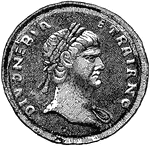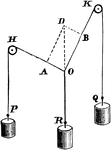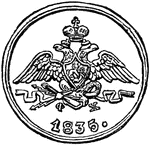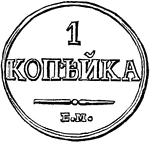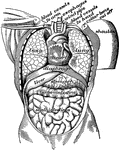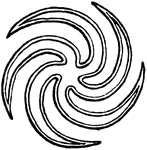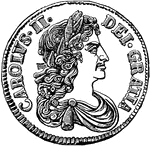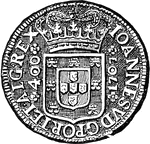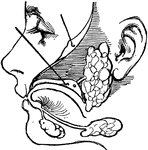
Salivary glands
"There are three pairs of salivary glands. One pair lies under the tongue; one pair is found under the…
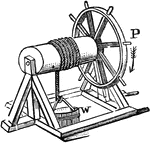
Wheel and axle
"The wheel and axle consists of a wheel united to a cylinder in such a way that they may turn together…

Diagram of a screw
"That the screw is a modified inclined plane, may be shown by winding a triangular piece of paper around…

Lift pump
"The lift pump or suction-pump consists of a cylinder or barrel, piston, two valves, and a suction pipe,…

Force pump
"The operation of the force-pump is similar to that of the suction-pump. The outlet-valve generally…

Fire syringe
"Place a bit of tinder in the cavity of the piston of the 'fire-syringe'. Put the piston into the open…
Siemens armature
"Consists of a coil of wire wound in two broad grooves plowed on opposite sides of an iron cylinder."…
Drum armature
"The drum armature differs from the shuttle armature chiefly in that it employs many coils instead of…
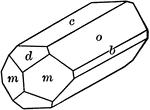
Celestite
"Orthorhombic. Crystals resemble closely those of barite. Commonly tabular parallel to the base or prismatic…

Armature core
"Side view of built up armature core. The sheet metal ring sections containing the teeth are fastened…
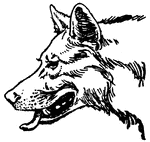
Mowgli's Brothers
A man's cub. "Look!" said Father wolf. In front of him stood a naked baby, who could just walk.
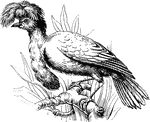
Umbrellabird
"The Umbrella Bird is a native of Peru. It is about the size of a crow, with deep black plumage; the…
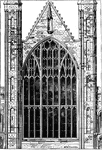
Window
Architecture of Cathredals in England. Perpendicular window, West Front at Norwich Cathedral, inserted…

Hydrometer
Nicholson's Hydrometer, consists of a hollow cylinder of metal with conical ends, terminated above by…

Hydrometer
Nicholson's Hydrometer, consists of a hollow cylinder of metal with conical ends, terminated above by…

Air Pump
This air pump contains a glass or metal cylinder called the barrel, in which a piston works. The piston…
Muscles of the Arm
"Muscles on the front of the arm. Note the while cords, the tendons at the wrist." —Davison, 1910

Sympathetic Nervous System
"Part of the sympathetic nervous system seen from in front, n, one of the two chief cords, t, i, and…

Modern house
"A modern small house with the 'lean-to' motif. Notice that the long slope faces the front." —Kinne,…

Thoracic duct and lacteals
"The lacteals conduct the chyle from the intestines into numerous glands nearby, called the mesenteries,…

Side View of the Body
A side view of the two great cavities of the body and their organs. 1: The mouth. 2: The thorax. 3:…

Front View of the Body
The position of the organs of the mouth, thorax, and abdomen. 1, 2, and 3: Salivary glands. 4: The larynx…

Knee-Joint
The right knee-joint, laid open from the front. 1: Articular surface of the femur. 2 and 3: Ligaments.…

Knee-Joint
Front view of the right knee-joint. 1: Tendon of the extensor muscle. 2: Patella. 3: Ligament of the…

Face
A side view of face. 1 and 2: Trachea. 3: Esophagus. 4, 5, and 6: Muscles. 7: Submaxillary. 8: Parotid…

Carnivorous Skeleton
The teeth of a carnivorous animal that lives on flesh alone. The front teeth are tearing ones, while…

Revolver
A firearm resembling a pistol, but differing from it in having a breech-loading cylinder so arranged…

Ruhleben Prison Camp
"A prophetic birds eye view of Ruhleben Prison Camp when the war ends."-1916; Drawing by Hobart Egremont,…

Tiger
A powerful carnivorous mammal of the cat family. The adult is about eight feet long and three to four…
Mercury Tube
This illustration shows the proportions of volume in which hydrogen and oxygen combine by introducing…
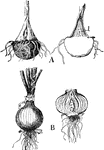
Onion
This illustration shows the shortened types of stems: A, corm of jack-in-the-pulpit. At left surface…
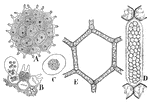
Green Algae
This illustration shows the colonial forms of unicellular green algae: A, Pediastrum, the plants of…
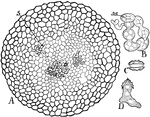
Ascocarp
This illustration shows further development of the ascocarp: A, sectional view, showing the branches,…

Mycelium
This illustration shows an enlarged view of the mycelium, ascocarp, etc., of one of the mildews, Erysiphe:…
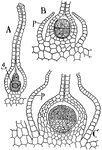
Gametospore
This illustration shows the germination of the gametospore: A, section of a mature archegonium with…

Funaria
This illustration shows the structure of capsule of Funaria: 5, capsule with calyptra, 5A, removed.…

Lepidium
This illustration shows stages in the germination of the gametospore of Lepidium, sectional view: A,…
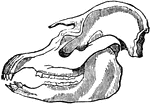
Tapir Skull
This illustration shows the skull of a tapir. Tapirs are large browsing animals, roughly pig-like in…
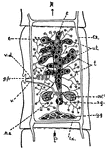
Tapeworm
This diagram shows some stages in the life history of the tapeworm. A, Cysticercus or Bladderworm stage,…
Annelid
This diagram shows a fresh-water annelid. a, appendages; br., brain; d, dissepiments; i, intestine;…

Snail
Diagram of the mouth of a snail, showing the lingual ribbon. br, brain; c, buccal cavity; co., caelom;…

Human Eye
This diagram shows a side view of the right eye of man. a.c., central artery; a.h., aqueous humor; b.,…

Right Cylinder
a solid which may be concieved as generated by the revolution of a rectangle about one of its sides.
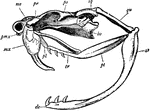
Rattlesnake Skull
This illustration shows the skull of a rattlesnake. ar, articular portion of lower jaw; de, dentary…

Vina
A stringed instrument used in Carnatic music. The vina is played by sitting cross-legged and holding…

